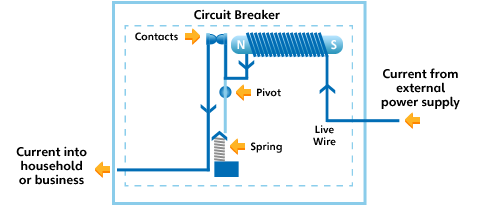Household circuits
All of us live and work in environments where electricity plays a part in everyday life as a flexible energy source, easily transformed into other forms. The circuits that are wired into a house by an electrician all start with wires coming in from power lines outside that are connected to a fuse and meter. The meters record how much electricity you use and therefore you will be charged for that use of energy. Electrical energy is sold in units called kilowatt hours.
Fuse Boxes
Fuse boxes contain safety devices called fuses or circuit breakers which are designed to prevent an excess of electric current entering your house by only allowing a certain maximum current to flow in. When the electrical current is too large, an electromagnet attracts a spring loaded switch which breaks the circuit and cuts the power supply. The switch must be reset before any current can flow again.
Safety tip: Circuit breakers and fuses prevent electrical fires and overheating that can be caused by an overload of electrical current.
Household Circuits
Circuits in houses are generally wired in parallel, which allows you to operate each light or power point independently of the others. This also means the current running through any one section of the parallel circuit stays small enough to prevent problems because in parallel circuits the current is split up and travels along each separate path.
Safety tip: When you use a power board or double adaptor, each device plugged in creates a new parallel circuit, but the total current for all of the devices must flow in the one house circuit. The current drawn by multiple devices in the circuit means that it is possible to exceed the maximum current draw allowed by the circuit fuse or circuit breaker. If the fuse or circuit breaker fails to operate then this can cause wires to overheat because even good conductors do provide some resistance to electric currents. This is why it can be very dangerous to piggyback double adaptors or to plug too many devices into a single power point. Usually, but not always, power boards have their own built in circuit breaker.
The diagram below shows the way most circuit breakers work.

Can you see:
- That the current from the power supply comes in from the right?
- That the current flows in a coil of wire which has a soft iron core inside it?
- That when current flows through the coil an electromagnet is formed? The strength of the electromagnet is directly related to the size of the current flowing in the coil.
- If the current grows too large, the circuit wires could be in danger of overheating. The electromagnet becomes strong enough to attract the side of the contacts closest to it. As this occurs, the contacts completing the circuit are broken and the current stops flowing?
A person must then reduce the current draw to a safe level, then reset the circuit breaker before the current can flow again.
Other safety devices used in household circuits
Safety Switches or Residual Current Device (RCD) – This is your lifeline against electric shock which is usually kept in the fuse box alongside a circuit breaker or fuse. Mainly known as safety switches in Australia but sometimes called RCD, these safety devices detect leaking current from faulty switches, wiring or electrical appliances. If it detects a problem that could put you at risk, it will turn the power off within 0.03 of a second. Each safety switch has a ‘test’ button, so it’s important that they are tested every couple of months.
Earth wires – Earth wires are designed to protect you from electric shock. They are attached to power points which join to a main earth wire, which is attached to a metal pipe and/or special metal electrode (metal stake) driven into the ground. The idea is that the electricity is given a more conductive path to the earth rather than through a person.
Surge diverter – These protect your personal appliances from voltage surges such as those resulting from a lightning strike. They do not protect people from electric shock. The surge diverter captures the voltage spikes in the wiring within the unit itself. This stops the voltage spike from transferring into your appliance and damaging it.
Additional content
The energy produced as heat in a wire depends on the size of:
- the wires resistance, R, to flow of charge, measured in ohms.
- the size of the electric current, I, flowing through the wire, measured in ampere.
- the time the current flows, t, measured in seconds.
This can be expressed by a mathematical equation, i.e. Energy lost as heat = Resistance x Current squared x the time the current flows, i.e.
EH = R I2 t
Note: that since having a low current means that the energy loss is minimised, it is common to use a transformer to step up the voltage of electricity to very high voltages up to 500 000 V for transmission over long distances. When this stepping up process occurs for voltage there is a corresponding decrease in electric current because energy is conserved as indicated in the Law of conservation of energy.
In this equation the current is squared, this means if you double the current in a circuit, the energy released goes up by 22, i.e. there is FOUR times more energy released.
